These 5 Management Practices Create Uncommonly Successful Workplaces
Want to know a modern management secret?
Ok, it’s not exactly a secret. I started explaining how we developed the Best-Self Management methodology in our last post. I shared how 15Five is a company of
nearly 80 people, with near zero attrition in our company’s history. We’ve been extraordinarily capital efficient, and based on a reputable benchmark, we were recently producing about 2x the average revenue per employee of companies at a similar size and stage. In 2018 we nearly doubled our annual recurring revenue while burning very little cash, and secured over $8Million in Series-A financing.
How did we do that?
We abandoned the most commonly practiced methods of leadership and management in lieu of management practices that produced the level of high performance and engagement so many companies are striving so hard to achieve. I’m sharing this with you so that you and your employees can achieve similar levels of success.
What does it take to activate Best-Self Management in your workplace?
There are a few key distinctions that I think are important to grasp, as well as a few important (but non exhaustive) concepts related to human growth and potential. Finally, you’ll need a high-level leadership strategy as well as specific management practices that all manager/coaches should engage in in your organization.
Let’s start with the distinctions:
#1) Being vs. Doing
Every individual and every group of people have both a being state (which is largely internal/invisible) and a doing state (which is largely external/visible). Here are some examples:
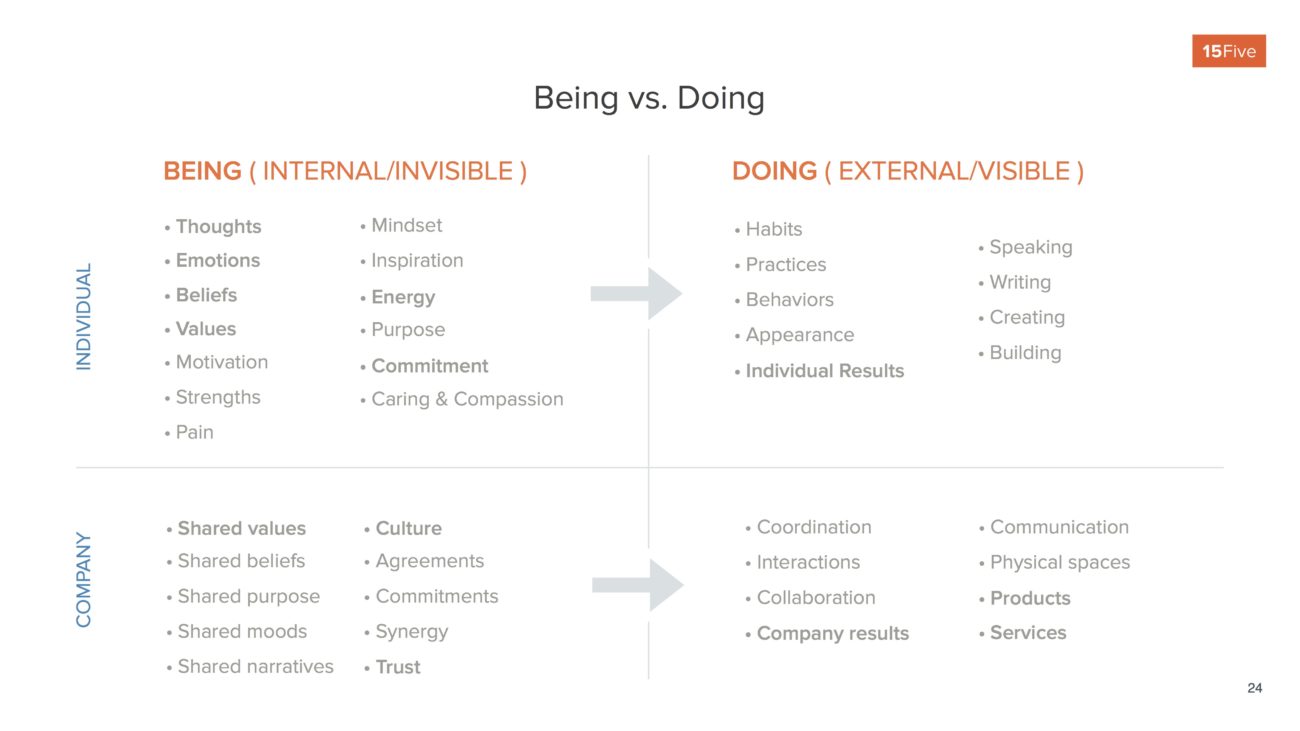
While it’s now nearly universally agreed that culture is a critical driver of success for an organization, that wasn’t always the case, not even ten years ago. Many business leaders I would speak with at the time were confused about its importance, dismissed it as “soft” or even denied its existence. One of the reasons is that culture isn’t something you can “see” (although I’d argue you can sense/feel it) or easily measure. But just as we can’t easily see or measure thoughts, feelings and emotions, I don’t think any of us would argue that they’re not real.
Not only are they real, but they dictate and determine what we do and even more importantly how we show up in what we do (e.g. are we centered, open, and curious, or are we frustrated, defensive, and closed?). On the group side of things, culture is a manifestation of the being state of a group of people.
Once again, the work culture (made up of shared purpose, beliefs, values, social norms, etc.) will play a major role in what people do and how they do it. The key principle here is that the internal/invisible being states, whether individual or collective, largely drive the external/visible doing, so they need to be cared for as much, if not more so, than the external doing. In many cases, if you get the being right, the doing takes care of itself. And if the being is off, no amount of incentives/rewards, punishments, commission plans, etc., are going to drive the sustained outcomes you’re after over the long term.
#2) Work vs. Life
I think it’s important to challenge this concept that we have a “work life” and a “personal life”. This flows out of the concepts or work-life balance or work-life integration.
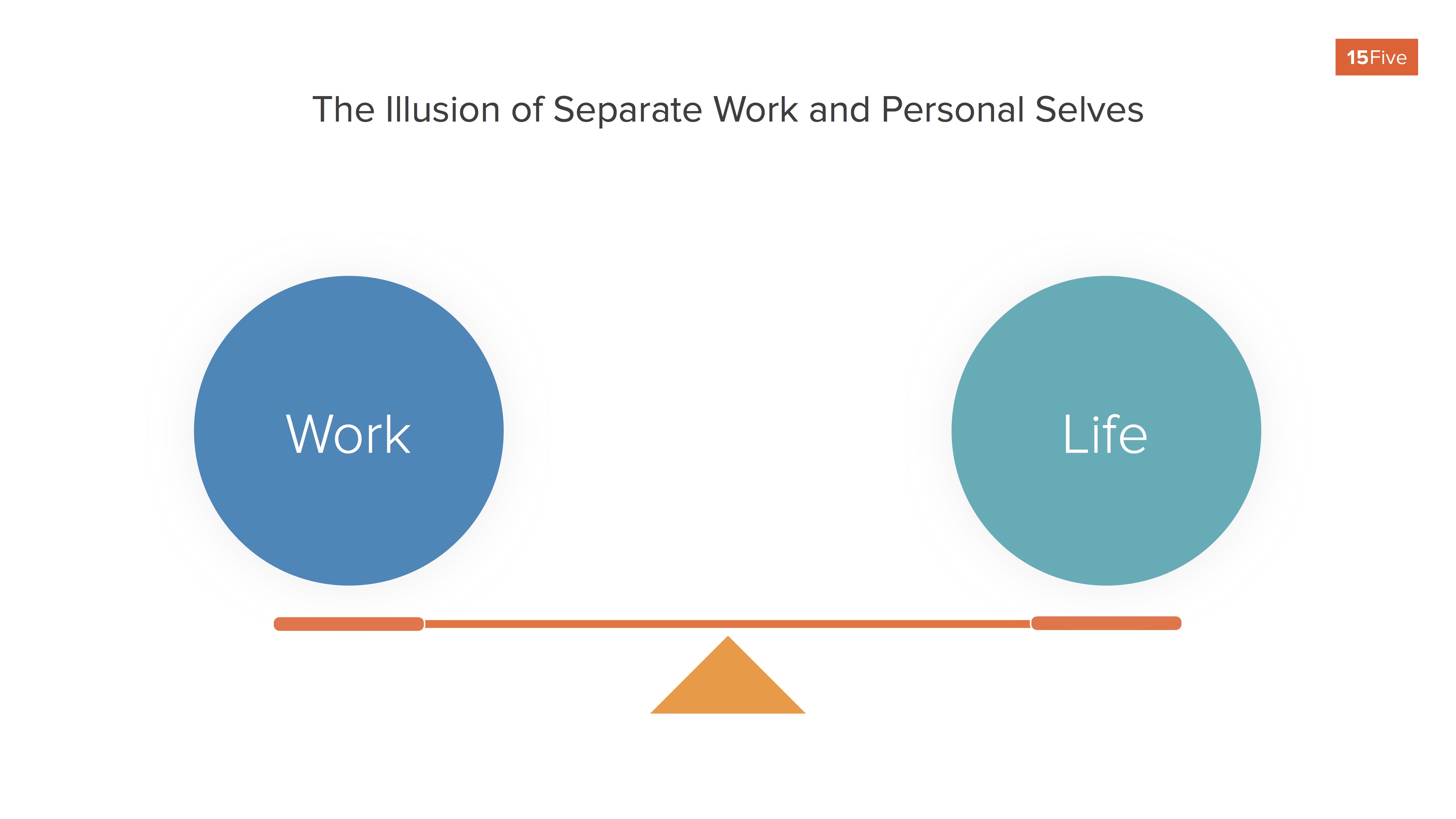
The reality however is that we really have just one life, and work is a big part of it.
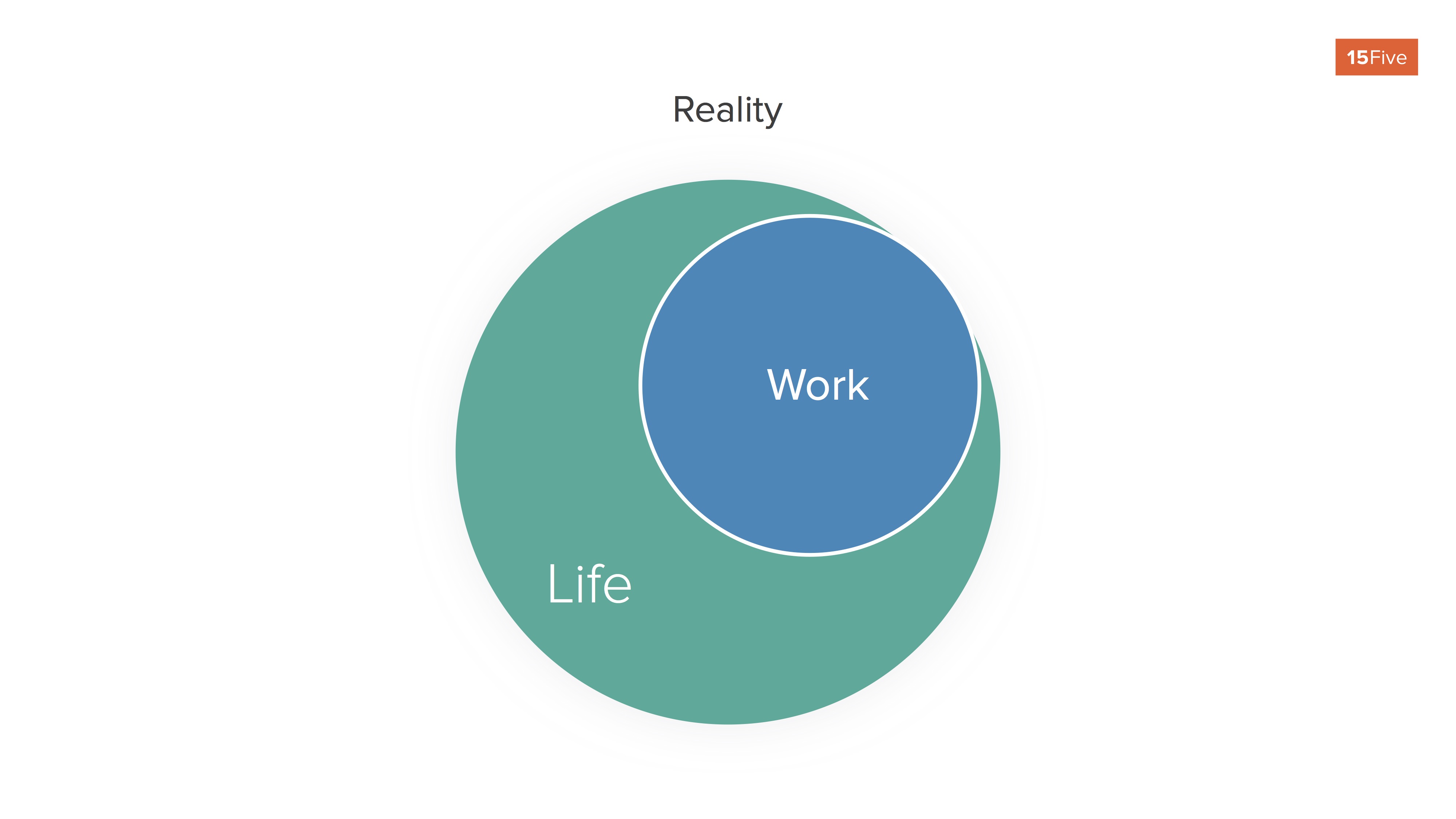
And for some of us, it might look more like this!
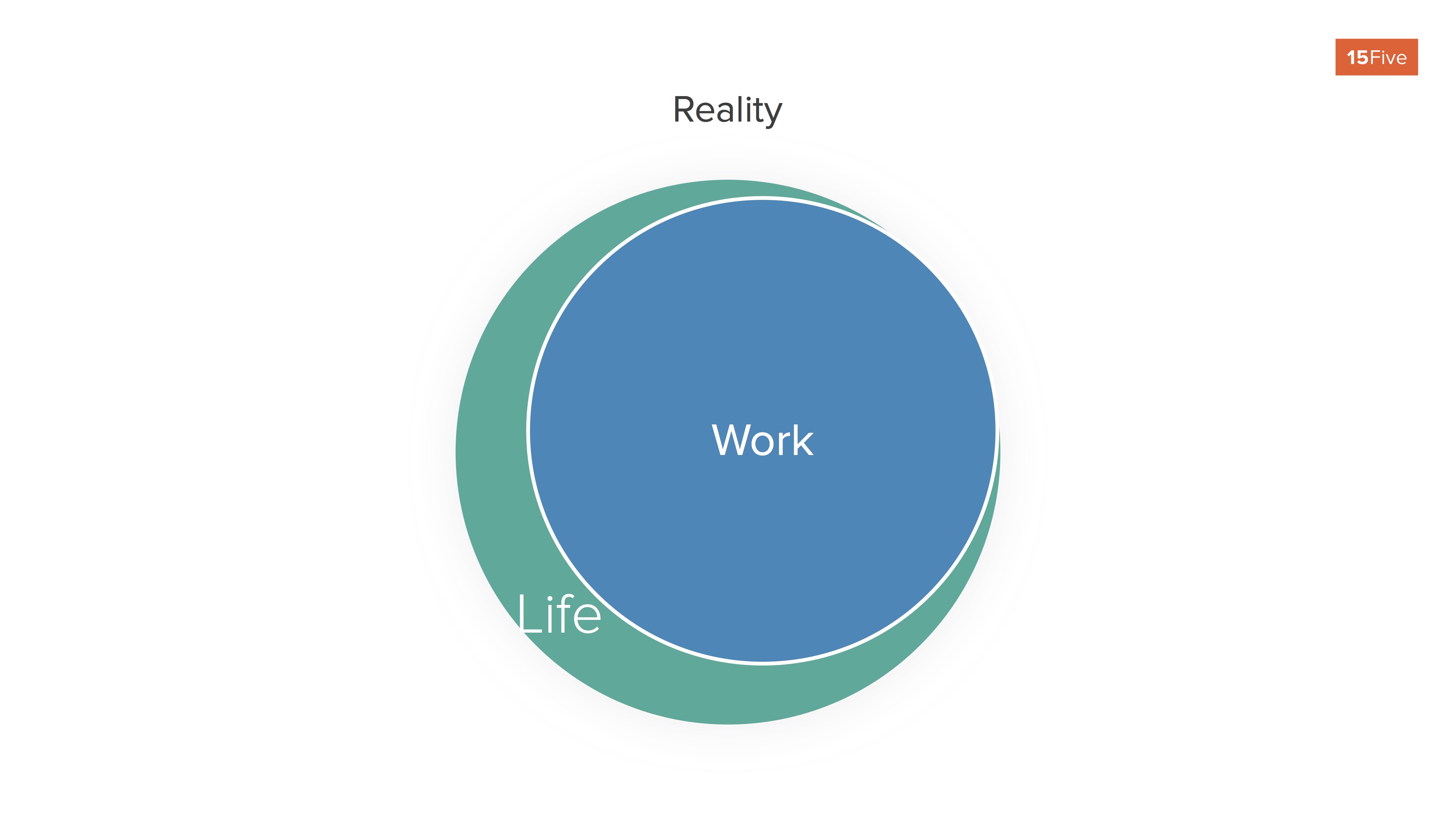
It follows that many leaders believe they shouldn’t have any concern for what a person is doing outside of the office. But the reality is if someone is having challenges in the workplace, that same self goes home and those challenges can impact their life outside the office.
More importantly, if someone is having challenges outside of the office, that same self comes in the office and those challenges affect how they’ll show up at work. So while I don’t believe as leaders we need to be responsible for people’s lives outside of the workplace, it is a far more powerful stance to bring empathy, care, and understanding to a person’s life. We need to make sure we’re not creating barriers to a person’s ability to adequately care for their life and family outside of the office, and even make a commitment to our people thriving not just in their work lives, but in their whole lives.
5 key Best-Self Management practices
Next, there are five keys that I’ve found are universally important in supporting people in being and becoming their best selves. It’s worth noting that this is a non-exhaustive list and that may other concepts and models can be added to this. However the five I’d like to speak to are:
1) Growth Mindset
2) Strengths -> Zone of Genius
3) Maslow & Psychological Safety
4) Intrinsic Motivation
5) Positive Psychology
Growth Mindset
If you haven’t yet read Carol Dweck’s book, Mindset, it’s a worthwhile read. She’s a Stanford University psychologist who did research into children and learned that some kids have what she calls a “fixed mindset” about themselves or at least some aspect of themselves, whereas others had what she calls a “growth mindset”.

Those with a fixed mindset believe that all or some of their traits are fixed, be it a particular skill, or their personality, intelligence, etc. Those with a growth mindset believe the opposite, that they or those aspects are malleable and can be improved or changed over time.
The studies showed that the kids with the growth mindset were more resilient, open to challenge, and weren’t as afraid of failure, whereas the kids with the fixed mindset were more likely to avoid challenges that might reveal their inadequacy, and would act in ways to protect themselves and keep them looking good, but weren’t as resilient and were less likely to grow, excel and thrive.
When it comes to creating a successful workplace, it’s essential for managers to understand which one of these buckets their people fall into. For instance, if you take a growth approach with a fixed person, this could be very counterproductive because it may be seen as an attack on their performance. Best-Self managers preempt this by orienting their teams toward a collective growth mindset as the foundation.
Managing Strengths
While it’s true we all have the capacity to grow and evolve, we don’t necessarily have the ability to grow equally in all domains. Each one of us has a unique set of innate talents or proclivities (one good method for learning these is the Clifton Strengths 34). Once you get clear on somebody’s strengths you can start to move people toward their Zone of Genius.
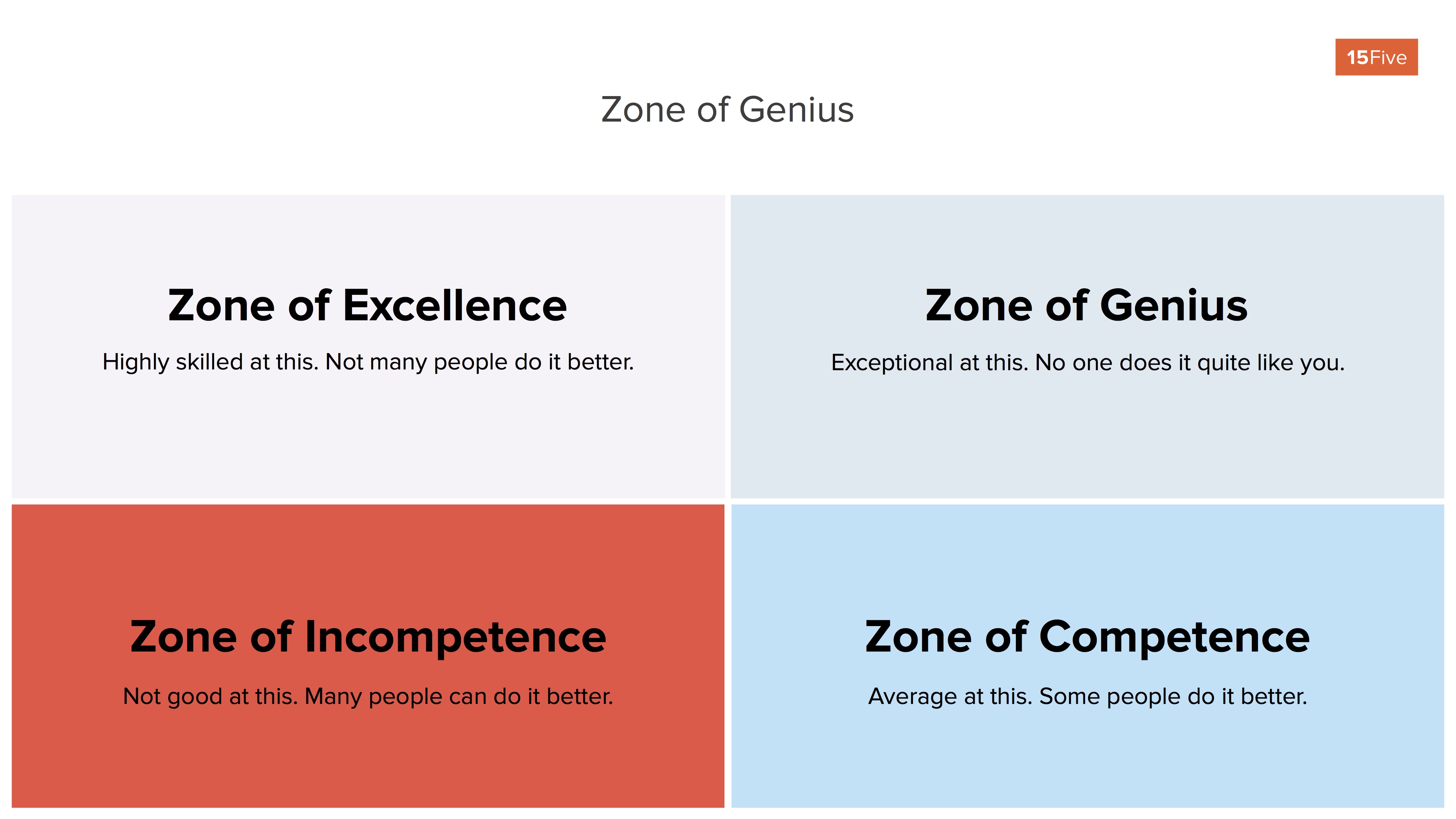
In any domain of doing, we each fall into one of the four boxes above — the Zone of Incompetence, the Zone of Competence, the Zone of Excellence (which is a trap that I’ll explain in a moment) and the Zone of Genius, our place of greatest potential contribution, characterized by experiencing periods of flow where we lose track of time and where the work inherently energizes us.
The distinction between the Zone of Excellence and Zone of Genius can sometimes be difficult to notice from the outside because the difference between the two is passion. In the Zone of Excellence we’ve likely honed those skills because we’ve gotten social recognition and monetary rewards for playing in that sphere, and been asked or chosen to contribute in that way, but it’s actually draining over time and doesn’t fulfill us. It’s a trap because if we don’t recognize that and give up those activities, we’ll never make space for the things are truly in our Zone of Genius, where we have an even greater potential to make our biggest impact, and where we have a sense of passion, fulfillment and positive energy.
I’ll give you a quick example. About two years ago I sat down with our head of marketing and asked her to inventory out all of her activities and share which ones gave her energy and which ones drained her. She was so good at everything she did so I was shocked to learn that nearly a full 50% of her activities she considered draining and work she’d prefer not to be doing!
It had been weighing on her to the point where she admitted she’d been having thoughts of possibly looking for another job. We hired a marketing coordinator whose Zone of Genius contained the very things she found draining. By offloading those tasks, we now had two employees spending most of their time in their Zone of Genius and stepping up into the next level of performance and contribution.
Maslow and Psychological Safety
Abraham Maslow astutely observed that as human beings we’re naturally wired to be and become our best selves, provided certain fundamental needs are being met, at least to a certain degree:
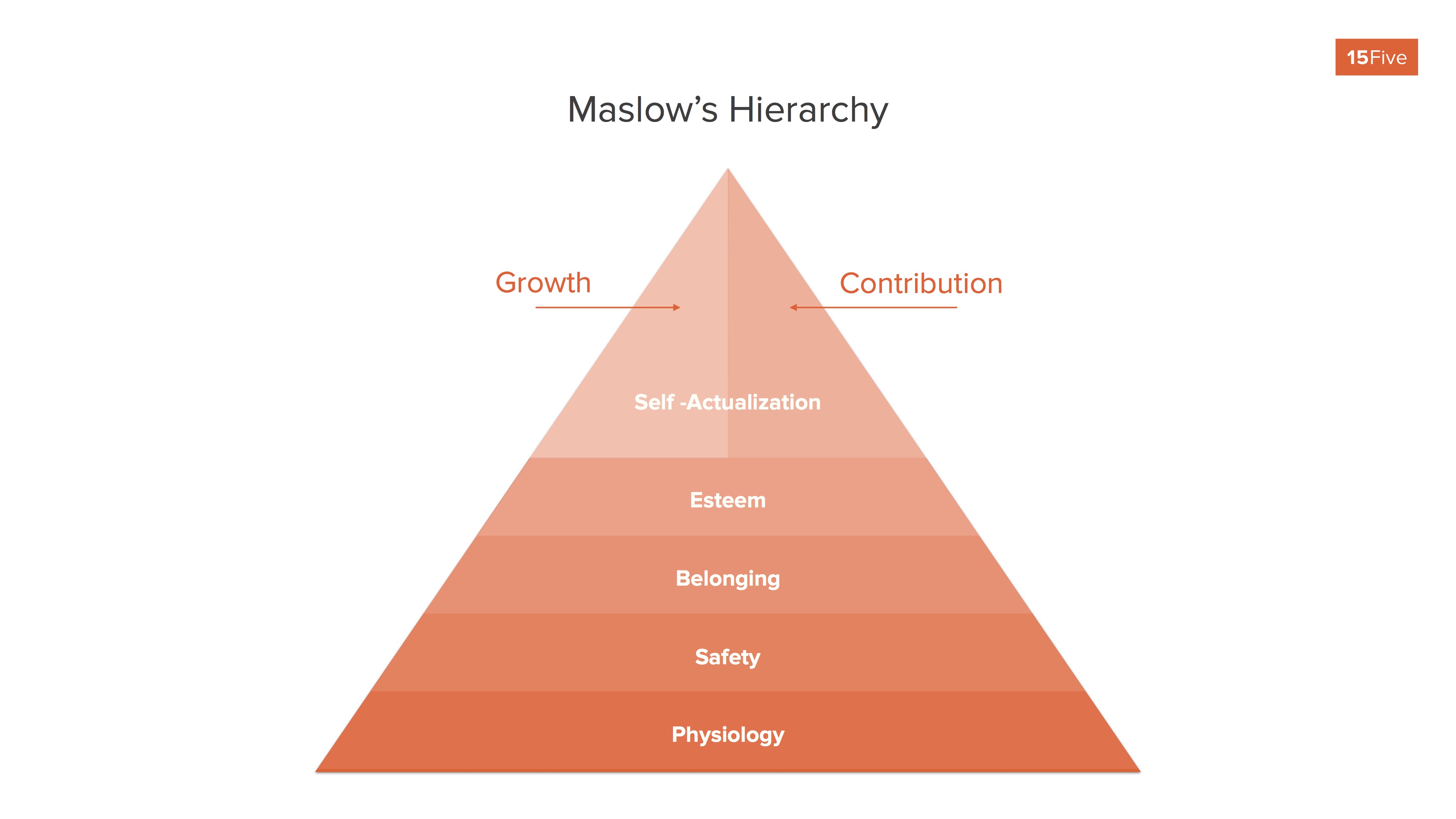
Whenever any of our lower needs are threatened, all of our attention goes there. For example, if I’m feeling socially insecure and lack self-esteem and I’m having chest pain, I’m not thinking about Esteem and Belonging, I’m fully focused on my physiological survival and probably calling 911. Thus, we’re always focused at the lowest level of threat.
The rungs on Maslow’s pyramid managers need to be mostly concerned with are Safety, Belonging, and Esteem. Unfortunately most organizations inadvertently create a feeling of threat and insecurity for their people where they don’t feel safe or they don’t feel they belong. Why this matters is because this maps to exactly the way our brains function.
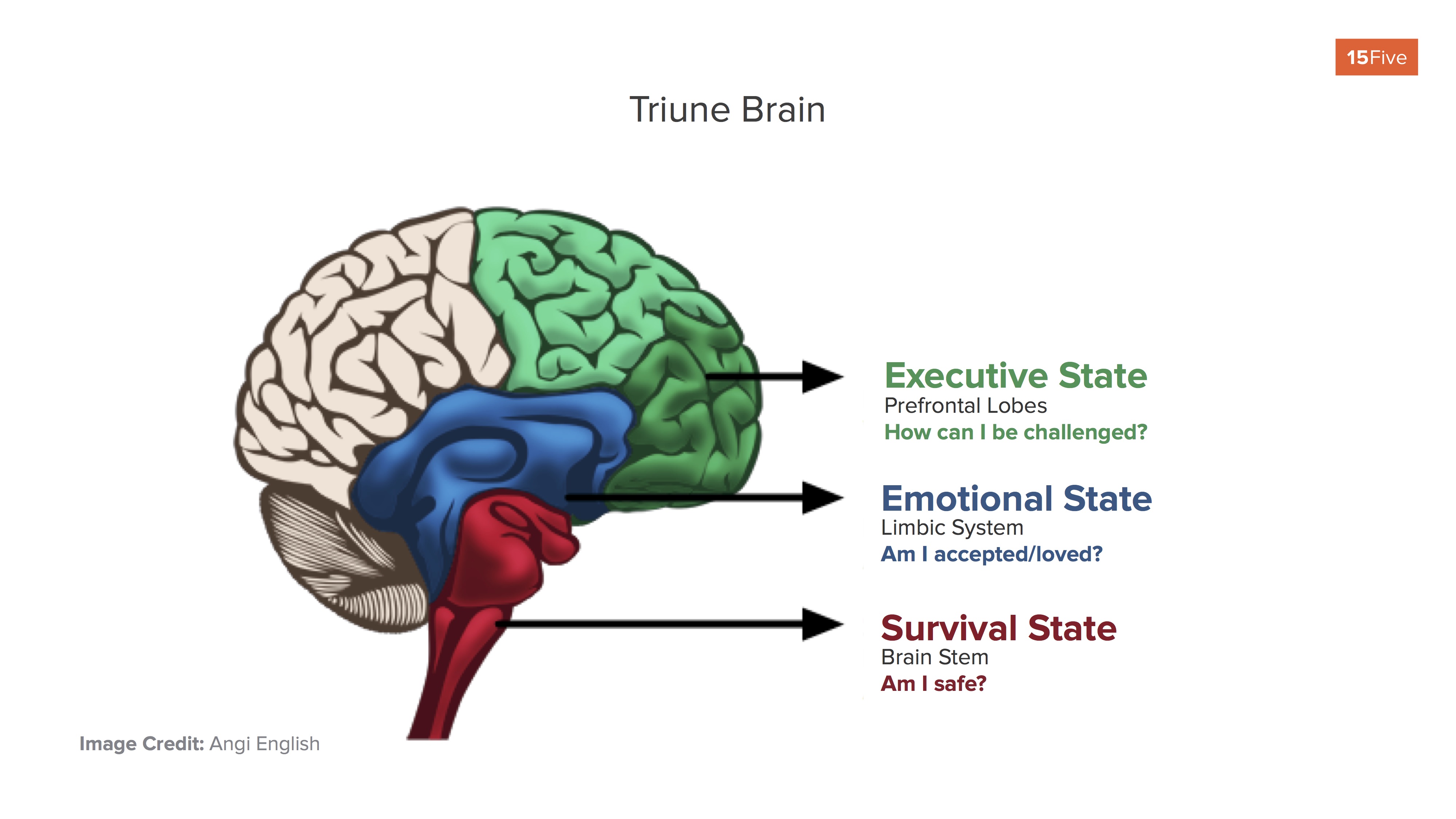
Our limbic system is constantly searching for threats. Our oldest brain, often referred to as the “lizard brain”, is always asking the question, Am I safe?
Our mid-brain, or mammalian brain, responsible for all of our emotions is asking the question, Am I accepted/loved?
If either of these two answers is no, or the perception is no, your employee is immediately brought into defense and is more likely to act in ways that seem to protect than to be open, curious, and fully contributing. This is why you’ll often see people in organizations covering for themselves or others. There’s gossip, toxicity, internal politics, lack of trust, withholding information, etc. If you even have any hint of this in your organization, it’s likely due to a lack of safety and/or belonging, which tends to be a symptom of some lack of health in the team or culture.
When the two needs of Safety and Belonging are met, that gives rise a state of psychological safety, the shared belief that the team is safe for interpersonal risk-taking. When people feel both respected (Safety) and accepted (Belonging) that part of their brains can relax and they are able to naturally access their higher order brain functions that thrive through challenge, creativity, passion, and intuition. This is where every employee makes their greatest contributions.
A major component of Best-Self Management is designing cultures to meet the needs of Safety and Belonging to create psychological safety, then allow people to work as much as possible in their Zone of Genius, to provide a strong sense of esteem. Provided then that our physiology is handled, this gives rise to us moving naturally into being and becoming our best selves, what Maslow called Self-Actualization.
Intrinsic Motivation
If you’ve read Dan Pink’s book, Drive, or seen his wonderful RSA Animate presentation, you’ll recall that he did a study on intrinsic motivation and determined that Autonomy, Mastery and Purpose were the prerequisites. I’ve combined that with research on motivation from Harvard Professor Rosabeth Moss Kanter, who found that Meaning, Mastery and Membership were required. Putting this together, we get the intrinsic motivation RAMP — Relatedness, Autonomy, Mastery, and Purpose:

Intrinsic motivation results from relatedness (a connection to others), autonomy (the freedom to work on a task, project or challenge using our unique strengths), mastery (the ability to keep getting better and better at what we do), and purpose (a connection to something greater than ourselves).
It’s critical to design for intrinsic motivation, because when somebody wakes up in the morning and is intrinsically motivated to do great work and bring their best, rather than being motivated solely by their paycheck or by the fear of losing their job, the quality of their contributions far exceed anything possible through mere external motivators.
Positive Psychology
Finally, it’s important to have a cursory understanding of the science of positive psychology, a field largely influenced by the work of Martin Seligman. While the majority of traditional psychology focuses on illness, positive psychology brings a much needed balance to the field by focusing on happiness, well-being, and the factors that contribute to a fulfilling life.
Shawn Achor gives a wonderful and hilarious overview of positive psychology in his TED talk, The Happy Secret to Better Work. The basic thesis is that our brains are by default wired to survive and not to thrive. We’re constantly searching for threats in safe environments (relative to the vast majority of human history), and when we’re in threat, as we discussed in the section on psychological safety, we’re operating out of our lower brain centers and literally not able to access our highest and clearest creativity.
However, we can retrain our brains to be more positively oriented through focused effort doing things like meditation and focusing on gratitude. This is why gratitude journals are so popular and effective. As it turns out, the positive brain is far more effective than the negative, neutral, or stressed brain. Shawn says that in a positive state, “your intelligence rises, your creativity rises, your energy level rises, and every single business outcome improves.”
For Best-Self Management to work you’ll need to train your managers accordingly:
• Every employee needs to know that you are committed to them thriving in their whole lives, not just their work lives.
• You must create a high degree of psychological safety and a help engrain positive brain states through regular team/company rituals and practices.
• Design for intrinsic motivation.
• Implement surveys and continuous feedback to understand how engaged and satisfied employees are.
• Resolve individual and systemic issues promptly before they fester and become bigger problems, or somebody ends up leaving. You need to vigilantly protect your culture from anything that could become toxic to it.
Best-Self Management Training
Once you’re operating with that leadership strategy, it’s important to make sure each and every manager is trained on what Best-Self Management is. Then implement each of the 5 key management practices below, which act like an iterative loop to continually support each employee on their journey during their tenure at your company:
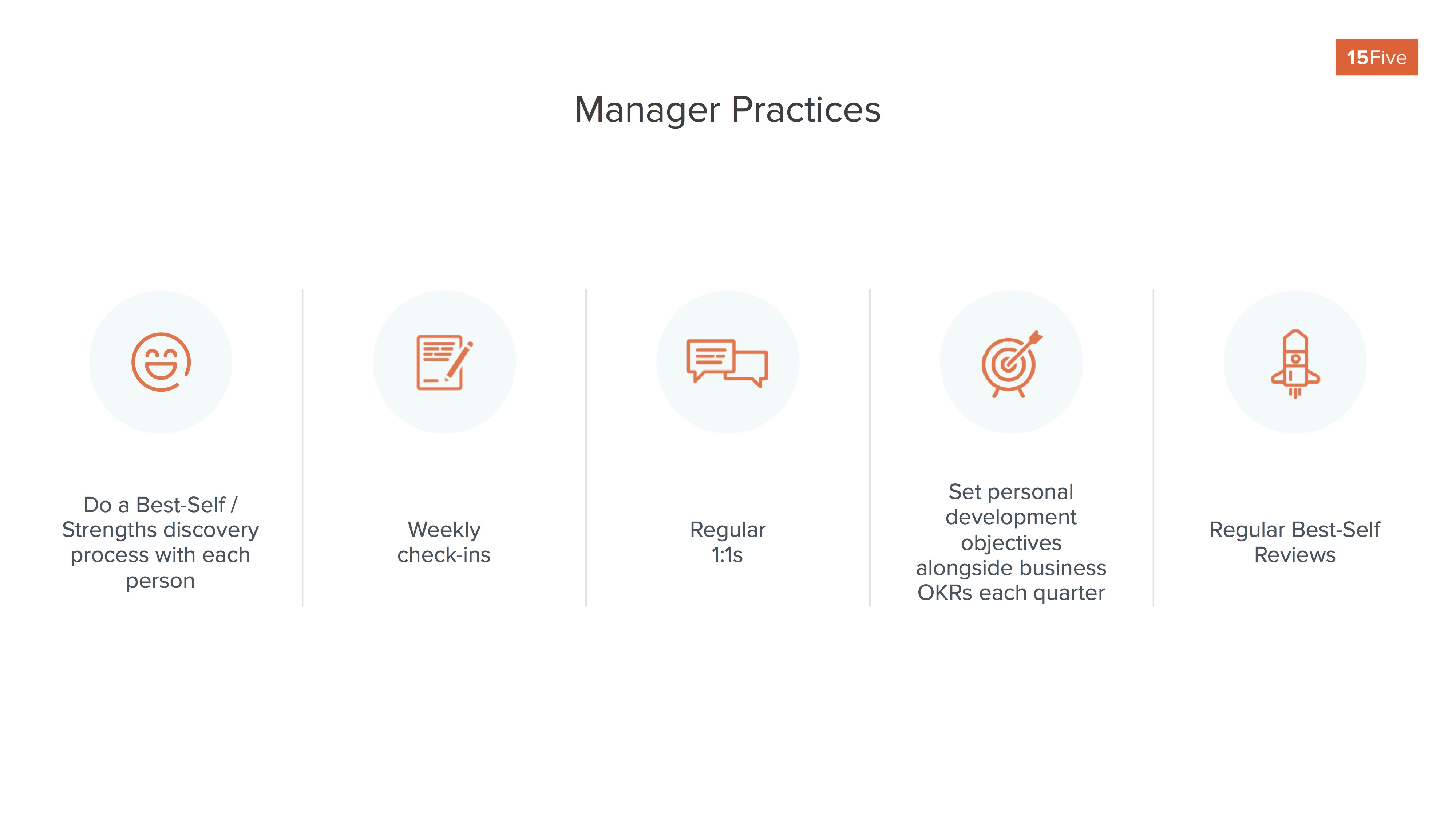
1) Managers need to initiate a Best-Self Discovery process with each of their direct reports. This helps employees self-reflect and get reflections from peers and other assessments to better understand what drives them, what their strengths are, and then clarify this into a statement for themselves around their potential Unique Ability or Zone of Genius. This is a process that should be returned to and refined periodically as people grow and develop.
2) Managers support each employee in setting at least one Personal Development Objective alongside their business Objectives (OKRs) during each quarter, or other period of time for which you set goals. Learning and growth never ends, and everyone needs to be focused on leaning into their next growth edge.
3) Managers engage in some form of weekly check-in. This can be done asynchronously and in a lightweight manager but it is essential. Employees need a place to regularly share their successes, challenges, progress on goals/OKRs, weekly priorities, and peer appreciation, and receive coaching and feedback along the way. This is the core of the 15Five product, and whether you use 15Five or not, this piece is critical.
4) Managers perform regular 1-on-1s (ideally in person, or via video with distributed teams) to go deeper on key issues that are often surfaced through the weekly check-in. I personally like a cadence of every other week, but these can range from as frequently as weekly to as infrequently as once per month.
5) Managers perform regular Best-Self Review™. This is our take on reframing the outdated annual performance review as an opportunity to support someone in being and becoming their best self, where high performance is the natural by-product. While we still advocate measuring and providing feedback on performance, we put a high degree of attention on helping to reflect and refine a person’s strengths, plan out their Personal Development Objectives, and continue to focus them on their own personal growth and development journey. In our model, the process is much more lightweight than a typical performance review, and can be done as frequently as once per quarter, but ideally no less than twice per year.
We’ve built 15Five to help facilitate the above process and will be working on a series of both leadership and manager trainings that we will be rolling out in 2019. We’ll go deeper into cultural design, shifting employee mindsets, giving and receiving effective feedback, and we’ll provide ways to measure the progress at your company.
If you’re a leader, all of the above requires you to genuinely and authentically care about your people, and care about them thriving in their whole lives, not just their work lives. When you activate the strategies and management practices I’ve outlined above, you have the opportunity to create an uncommonly powerful environment where your people can produce extraordinary results.
Best-Self Management is a truly win-win paradigm of leadership and management, and I believe that if we take this on together, we have the possibility of creating a more inspired, powerful, and purposeful world where everybody wins.
I’d love to hear feedback in the comments below about what resonated for you, and I hope you’ll help lead the way inside your company to create an entirely new world of work.

David Hassell is cofounder and CEO of 15Five, performance management software that includes continuous feedback, OKRs, peer recognition, 1-on-1s, and 360° reviews. David speaks and writes about leadership and was named “The Most Connected Man You Don’t Know in Silicon Valley” by Forbes Magazine. Follow him @dhassell.




